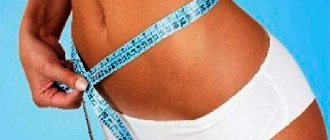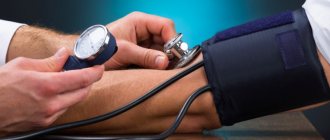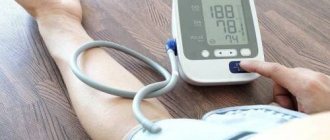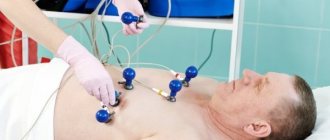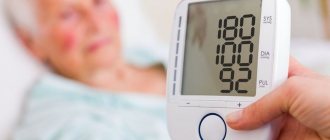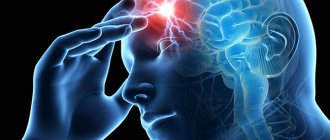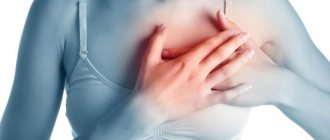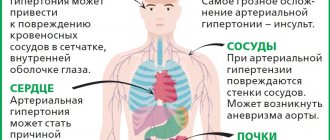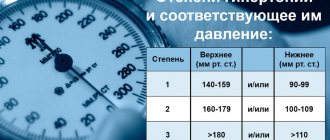Hypertension and its consequences are one of the most common causes of mortality. According to Rosstat, diseases of the circulatory system rank first in the number of deaths. They account for 46.8% of all cases. Therefore, high blood pressure cannot be ignored. Even in the absence of severe symptoms, it is recommended to regularly take measurements with a tonometer. And if deviations from the norm appear, consult a doctor immediately.
Hypertension and high blood pressure
Blood pressure (blood pressure) is the pressure that blood creates on the walls of blood vessels from the inside. From the outside, the vessels are compressed by the atmosphere. So that blood can circulate and the vessels do not close under the influence of external force, the heart pumps blood at a pressure exceeding atmospheric pressure. Measurements are taken in millimeters of mercury. There are arterial, venous, capillary, intracardiac, and pulse pressures. Normally, the work of the heart muscle ensures a blood pressure of 120/80 mmHg. Art. The first number shows the systolic pressure at the moment the blood is pumped out by the heart. The second number is the diastolic pressure between heartbeats, it shows the resistance of the peripheral vessels to the further movement of blood. The difference between the upper and lower values is called pulse pressure.
During physical activity, sudden changes in temperature, and stress, indicators may increase, but quickly return to normal, as the body adapts to the changed conditions. A persistent increase in blood pressure is called hypertension or hypertension.
Hypertension affects all organs and worsens overall health. Without treatment, it leads to irreversible pathological changes, and in severe cases, death. There are three forms of the disease:
- Easy. Blood pressure readings range from 140/90 – 160/100. At this stage, the risk of organ damage is low. But the danger lies in the fact that a person may not notice or ignore the symptoms, miss the onset of the disease, and it will progress.
- Average. Characterized by pressure 160/100 – 180/110. At such values, damage to the heart, eyes, and kidneys begins. Pathologies can develop over several years. If treatment for hypertension is started in time, changes can be slowed down.
- Heavy. Blood pressure 180/110 and above. This condition is extremely dangerous, as it leads to rupture of blood vessels. Depending on the location of the hemorrhage, stroke, heart attack, blindness, and failure of internal organs occur.
It is important not to miss the first signs of hypertension and keep the readings as close to normal values as possible.
Regulatory data
The level of blood pressure, diastolic and systolic, is influenced by:
- general condition of the body's blood vessels;
- gender;
- patient's age;
- stressful situations;
- overwork;
- physical exercise;
- a certain way of life.
The difference between the two is related to the physiological processes taking place in the human body. Contraction of the heart muscle provokes a blood discharge that affects the left ventricle. Subsequently, as the blood moves through the arteries, capillaries and veins, the blood pressure level gradually decreases. As the flow returns back to the heart, it will be minimal.
Table of normal indicators:
| Blood pressure in mm | Diastole in mm | Systole in mm |
| Norm | 80 | 120 |
| Valid values | 81-85 | 121-130 |
| Excess | 86-89 | 131-140 |
| Hypertension 1 st. | 90-100 | 141-160 |
| Hypertension 2 tbsp. | 101-110 | 161-180 |
| Complex hypertension | over 110 | above 180 |
Symptoms of hypertension
Signs of pathology are the following conditions:
- Headache, often in the occipital region. May not respond to analgesics.
- Pulsation in the head, noise in the ears.
- Dizziness may occur with a sudden change in position.
- Decreased visual acuity, darkening of the eyes, sensation of “floaters”.
- Chills, increased sweating, rapid pulse, nausea.
- Nose bleed.
- Redness of the face and ears.
- Feelings of anxiety, restlessness, increased fatigue.
Symptoms may indicate more than just hypertension, but when one or more conditions appear, it is recommended to first measure blood pressure. If the values are higher than normal, consult a therapist or cardiologist.
Causes of high blood pressure
When measuring pressure, the state of blood flow is assessed - how correctly the blood circulates through the vessels. Hypertension occurs when circulation is impaired and more force from the heart is required to push blood through the vascular bed. This can happen for several reasons:
- Increased blood volume. In this case, the blood puts more pressure on the vessels. Normally, to compensate for excess fluid, the walls of blood vessels stretch, and the pressure normalizes. But, when tissue elasticity is lost, stretching does not occur or is insufficient. Typically, blood volume increases with increased salt intake.
- Narrowing of the lumen of blood vessels. The cross-section of the vessel becomes smaller, making it difficult for the fluid to pass through. In the short term, this condition develops against the background of stress, physical activity, and a sharp drop in temperature. These are reversible reactions. A common cause of constant narrowing of the lumen is atherosclerosis - the deposition of cholesterol plaques.
- Increased blood viscosity. This condition is caused by dehydration, diseases of the immune system, metabolic disorders, obesity, varicose veins, dietary errors, alcohol consumption and other factors. To ensure that thicker blood circulates, high pressure must be created.
A systemic increase in blood pressure indicates chronic pathology. In addition to normalizing blood pressure, it is necessary to diagnose the cause and carry out complex therapy.
Upper, lower, pulse pressure
The upper, systolic, cardiac pressure indicates the work of the heart at the moment of pushing out blood. An increase in the upper indicator is accompanied by a rapid pulse, discomfort in the chest area, and shortness of breath. High systolic pressure accelerates wear and tear of the heart and leads to structural changes in the myocardium. Long-term hypertension may develop:
- Coronary heart disease is a decrease in blood circulation in myocardial tissues.
- Heart failure is incomplete filling and emptying of the ventricles.
- Infarction is the formation of a necrotic focus in the myocardium.
- Left ventricular myocardial hypertrophy is the growth and thickening of muscle tissue, which leads to impaired contractile function, up to sudden cardiac arrest.
Lower, diastolic, renal pressure depends on the condition of the blood vessels. Manifestations of high diastolic pressure are muscle weakness, visual disturbances, and dizziness. Also, the need to control blood pressure is indicated by kidney disease, swelling, difficult diuresis during the day and excessive urination at night.
Consequences of hypertension with high renal pressure:
- Stroke is an acute disorder of cerebral circulation, which may be accompanied by hemorrhage.
- Renal failure - due to tissue nutritional disturbances, the kidneys cannot work normally, intoxication begins with damage to all organs and systems.
- Deterioration in the elasticity of blood vessels - fragility, microhemorrhages, and hematomas appear on the skin.
- Malnutrition of the limbs - peripheral blood circulation is hampered with the possible formation of ulcers and the development of gangrene.
Also important is the difference between the upper and lower indicators - pulse pressure. Normally it is 30-50 mmHg. When it decreases, lethargy occurs, throbbing headaches in the frontal and occipital regions, cognitive function is impaired, and the ability to concentrate decreases. A decrease in the indicator may occur due to:
- Atherosclerosis, aortic aneurysm.
- Kidney nutritional disorders.
- Aneurysms with different localizations, including cerebral vessels.
- Inflammation of the serous membrane of the heart.
- Hemorrhages.
With increased pulse pressure, the myocardium regulates blood circulation with great tension, which provokes disturbances in the functioning of the heart, characteristic of high systolic pressure.
How?
The symptom of high diastolic pressure is headache. To check what your blood pressure is, you need to measure it using a sphygmomanometer (tonometer). Modern digital semi-automatic tonometers allow you to limit yourself to only a set of pressure (until a sound signal), further release of pressure, registration of systolic and diastolic pressure, and sometimes pulse and arrhythmia, the device carries out itself. Automatic blood pressure monitors themselves pump air into the cuff; sometimes they can produce data in digital form for transmission to a computer.
At-risk groups
All elderly people are at risk of developing hypertension due to the natural aging of blood vessels and the heart. At an earlier age, the likelihood of high blood pressure is higher if:
- Diseases of the kidneys and blood vessels.
- Congenital heart defects.
- Obesity.
- Alcohol abuse, smoking.
- Frequent stress, disruption of work and rest schedules.
- Systematic intoxication with harmful substances.
- Eating foods high in cholesterol and salt.
- Diseases of the endocrine system.
People who have had head injuries or heart and brain surgery should also monitor their blood pressure.
Rules for measuring blood pressure
The complete procedure for measuring blood pressure (BP) consists of 4 measurements - 2 times in the brachial artery on one and the other arm, but at home and even at a doctor’s appointment they are limited to one measurement on the left arm. Modern automatic blood pressure monitors can also measure pressure at the wrist level, but their readings are not always accurate (read more here).
Standard positions for measuring blood pressure
The main condition for self-monitoring of pressure is a preliminary 5-10 minute rest in the body position in which the measurement will take place.
The lowest blood pressure readings are recorded during sleep, between 2 and 3 am. After waking up, a 30-60 minute surge is observed, which, although insignificant, may exceed the norm. The highest blood pressure readings are, of course, recorded in the evening.
On a note. If the blood pressure cuff is placed on the elbow, then the forearm should lie so that it is at the level of the heart. When measuring pressure on the wrist, fix your hand as in the photo below.
Elbow – not suspended, cuff – at heart level, hand – in natural position
Danger to organs and body systems
- Heart. Due to the increased load, the walls of the myocardium begin to grow, especially the left ventricle, which works to eject blood. With tissue hypertrophy, nutritional deficiency begins, wear accelerates, and elasticity decreases. As a result, arrhythmia, bradycardia, ischemia, and heart attack may develop.
- Vessels. Constant tension makes blood vessels fragile, deforms them, and leads to ruptures. Hypertension increases atherosclerotic deposits, up to complete blockage. First of all, the capillaries that provide nutrition to the internal organs, eyes, and limbs are affected.
- Brain. Insufficient brain nutrition in hypertension leads to cognitive impairment. The most common cause of strokes is hypertension.
- Kidneys. Lack of blood circulation leads to the accumulation of toxins. The kidneys cannot cope with excretion in full; they do not have enough nutrients to recover. This leads to the development of kidney failure and further worsens the condition of blood vessels, as harmful compounds remain in the blood.
- Eyes. Hypertension can cause damage to the optic nerve, and in the most severe cases, blindness occurs.
How to Prevent the Dangers of High Blood Pressure
When diagnosed with hypertension, a full examination is required to find the cause due to which the pathology develops. At the same time, it is important to stabilize indicators in order to reduce the risks of developing a crisis and complications.
- You need to measure your blood pressure several times a day, preferably at the same time. It is better to record the data and take it to a doctor’s appointment - this will allow you to track the dynamics and identify patterns.
- Under no circumstances should you stop taking prescribed medications on your own. If persistent improvement occurs during therapy, patients often stop taking medications. You can't do this. Cancellation, reduction of dosages, replacement of one drug with another is carried out only under the supervision of a doctor.
- It is necessary to adhere to a daily routine and avoid overwork. It is easier for the body when the usual rhythm is not disturbed.
- At the first sign of deterioration, seek help. Fluctuations in indicators and progression of hypertension can cause a crisis, heart attack, or stroke, so any changes should be reported to the doctor to adjust therapy or conduct additional examination.
Since hypertension affects all organs and systems, regular restorative and supportive courses are recommended for blood vessels, heart, and other organs as indicated.
Treatment of diastolic pressure
To normalize diastolic parameters, medications and traditional medicine are used. To avoid the development of hypertension and hypotension, you need to eat properly, irregularly, move more, and get rid of bad habits.
If the condition quickly returns to normal and does not cause deterioration in well-being, then there is no particular cause for concern, but for prevention, you should undergo a full examination once a year.
How to lower diastolic pressure?
Various medications are used to treat isolated hypertension, but they should be taken under constant medical supervision - almost all drugs provoke a decrease in systolic parameters, which can lead to the development of concomitant pathologies.
Main groups of medicines:
- Beta blockers - Metoprolol, Nebivolol. Effectively reduces the frequency and strength of heart contractions, which leads to normalization of diastolic values. It should not be taken by people with asthma or lung diseases.
- Calcium channel antagonists – Phenigidine, Corinfar. They influence the functioning of the smooth muscles of the myocardium, improve vascular tone - the pressure is equalized.
- Myotropic antispasmodics – Papaverine, Papazol. The safest antihypertensive drugs.
- Nitrates – Erinite, Cardiket. Promote the expansion of the duct in the veins and arteries, the pressure quickly decreases.
- Diuretics – Lasix, Furosemide. Remove excess fluid and eliminate swelling.
All drugs are initially prescribed in a minimum dosage, and the doctor can gradually increase it if necessary. If the condition does not improve within 3–4 weeks, therapy should be completely reconsidered and re-examined.
Cold will help to quickly reduce blood pressure - you need to lie face down and place ice or a bottle of cold water on your neck. The duration of the procedure is a quarter of an hour, then you should massage your neck to restore blood circulation. Additionally, you can rub your ears red and take a few deep breaths.
Alternative therapy methods
Many folk remedies help to effectively reduce diastolic readings and prevent the development of hypertension. Even natural medicines can only be taken with the permission of the attending physician.
- A tincture of spruce or pine cones helps well with hypertension - you need to fill a 1-liter glass jar with the raw material, compact it a little, and fill it to the top with high-quality vodka. Close the container, place in a dark room for 3 weeks, filter, take 5 ml before each meal. Treatment should be continued until the tincture runs out.
- If the pressure is very high, viburnum will help - squeeze the juice from 500 g of fresh berries, mix with 500 ml of fresh honey, add 180 ml of cognac. Place the mixture in a closed container in a dark place for 4 weeks, stir the medicine once a day. Take 15 ml tincture three times a day with meals.
Proper nutrition will help improve the condition of the circulatory system and blood vessels; the diet should contain more foods that contain sodium and potassium - baked potatoes in their skins, all types of cabbage, corn and bananas. There is a lot of magnesium in raw nuts, seafood, and legumes.
Increase in lower pressure readings
If there is a sharp decrease in diastolic readings, you need to lie down and put your feet on a small hill to normalize blood circulation. Strong, sweet green or black tea will help improve your well-being, or you can eat something salty. 1-2 tablets of Citramon will help improve your performance.
Folk remedies for the treatment of hypotension
Tinctures and decoctions of medicinal plants, juices, and herbal teas will help normalize diastolic indicators.
Effective ways to increase blood pressure:
- Every morning for a month, drink 200 ml of natural grape juice with the addition of 25 drops of lemongrass or ginseng tincture.
- Mix 10 g each of tansy, immortelle, key steelweed and immortelle. Brew 5 g of the collection with 220 ml of boiling water, leave in a closed container for 20 minutes. Drink the drink every morning before breakfast.
- Cinnamon will help to quickly and permanently increase diastolic pressure - ¼ tsp. Brew 200 ml of boiling water, cool, add 15 ml of honey. Take the medicine in the morning before breakfast, 2 hours before bedtime.
If you have low blood pressure, you need to sleep for at least 9 hours in a cool room and take a contrast shower in the morning. The diet should contain moderately salty and sweet foods.
What to eat if you have hypotension
Proper nutrition is a safe way to increase diastolic values without worsening systolic values.
What foods help increase blood pressure:
- berries – black currant, sea buckthorn, lingonberry;
- citrus fruits;
- natural pomegranate juice;
- potatoes, carrots, celery;
- spicy vegetables - onions, garlic, horseradish;
- medium fat dairy products – cottage cheese, hard cheese;
- red lean meat, fish;
- bitter dark chocolate;
- raw nuts, dried fruits.
You need to drink more - pure water without carbon, regular and herbal teas, and a decoction of rose hips.
Only a doctor can determine the reason for the increase or decrease in diastolic readings. Isolated hypotension and hypertension require careful diagnosis, which will reveal the true cause of the decrease in pressure.
Prevention of hypertension
Prevention of hypertension is not specific. To reduce the risk of developing the disease, it is recommended to adhere to the rules of a healthy lifestyle:
- Stop smoking and do not abuse alcohol. Alcohol and nicotine destroy blood vessels.
- Normalize weight. Obesity itself can cause hypertension. In some patients, weight loss restores normotension without medication.
- Do physical education. Cardio exercise of at least 150 minutes per week and walking are especially effective for strengthening the cardiovascular system.
- Balance your diet in terms of calories and composition. It is necessary to consume fiber daily and reduce animal fats and salt in food.
- Monitor your drinking regime. Insufficient water leads to blood thickening and retention of toxins. The norm for an adult is 2 liters per day.
If possible, it is better to avoid stress and overexertion, get enough sleep and spend time outdoors.
Methods for normalizing DBP
Treatment of diastolic pressure at home is carried out comprehensively, with the help of medications, traditional methods, diet therapy, and activation of the motor mode. If you are overweight, you will need to lose weight. In any case, you should give up bad habits. The selection of a specific regimen depends on an accurate determination of the cause. Treatment, in some cases, will be lifelong.
Reducing high values
How to lower lower blood pressure?
If diastolic blood pressure “jumped up,” then how to bring it down is a question that can be solved in several ways. If the jump is due to overwork, then a leisurely walk in the fresh air, a hot foot bath, tea with mint and lemon balm, and sleep for 8 hours are best. Are you nervous? Drink a sedative.
"First aid" to reduce high blood pressure when stopping an attack of angina pectoris
To treat persistent hypertension caused by pathological causes, today the cardiologist has the following drugs in his arsenal to lower diastolic blood pressure:
- diuretics – hypothiazide, indapamide, spironolactone, eplerenone, torasemide, furosemide;
- calcium antagonists – amlodipine, nifedipine, verapamil, diltiazem, lacidipine;
- β-blockers - metoprolol, bisoprolol, nebivolol, betaxolol, carvedilol;
- ACE inhibitors – zofenopril, captopril, lisinopril, perindopril, ramipril, trandolapril, quinapril, fosinopril, enalapril;
- sartans - valsartan, irbesartan, candesartan, losartan, olmesartan, telmisartan, eprosartan;
- neurotropics – moxonidine, rilmenidine, methyldopa;
- sedatives, tranquilizers, sleeping pills;
- α-adrenergic blockers – doxazosin.
What specific drug and in what dosage will need to be taken is decided by the doctor. To achieve normal blood pressure and maintain it, you may need to select a combination of several drugs.
